hey friend!
I'm Martina.
I provide practical, time-saving strategies that actually work—so you can engage your students, teach effectively, and reclaim your time from the exhausting planning-grading cycle.
Browse Our ELA Resources
Writing Conferences in Middle School English Language Arts
This blog post is a kind of spin off of my Narrative Writing blog post that talks all about writing narratives in middle school English Language Arts. This post is more in-depth about how I do Writing Conferences and peer-editing in my 7th and 8th grade English Language Arts classroom.
Writing Conferences are probably the thing that I had the most questions about during my last 6 years as a teacher. Mostly, I wondered how in the heck do teachers (especially middle school ELA teachers who have 100+ students) do conferences?! In my first couple years of teaching it seemed literally impossible (and that was when I was self-contained in 5th grade with just 24 students).
I would always have these moments of, “Oh, this would be a good time to do conferences.” ***Usually sometime in April or May when we finally figured out our routines and my students were independently working for a few minutes #sorrynotsorry.
I would get a few done, love it and think about how I was going to commit to doing it every day…. then the next day would be a hard lesson and too many kids needed help…. or we had an assembly that interrupted our writing workshop time…. or I would have other stuff that needed to get done during the time.
Even worse, I would sometimes have the time to do writing conferences, would pull a kid to do one, and then be like, “What the hell do we talk about?!”
You get the picture.
I just had such a hard time being consistent with it every single day and I didn’t really know what I was doing. To be clear, I’m still not that consistent and I still struggled a bit with how to help my really strong eighth grade writers last year, but I have finally figured out a system that works for me and actually allows me to get through anywhere from 7-10 students in 55 minute class period, and it’s ACTUALLY HELPFUL AND USEFUL when I meet with the students.
I will also say that last year was my first year in middle school English, and I was still figuring out what the expectations were for a middle school writer. When I would sit down to help a kid, I didn’t really know what a strong narrative, literary analysis, or rhetorical analysis should look like. That made it difficult for me to help my strong writers, in particular.
After a year of seeing really good and bad examples of each, I am WAY BETTER at giving all my students (no matter what their writing ability) actual guidance in the writing process. So give yourself some grace as you figure out your conference systems as well.
So this is how I do it. It may not be what all the fancy schmancy writing gurus recommend, but I think that writing conferences are super important and super helpful so I do what works for me to actually make me do writing conferences.
First of all, I made four different binders for each of my four ELA class periods. I created a tab for each students and put writing conference forms behind each students tab so I could fill out their conference information as I went to them. I keep all my binders on a bookshelf behind my horseshoe table.
I used to pull all my students to my horseshoe table for everything, but I am much more flexible with this now.
I try to teach a true mini-lesson. For narrative I created my own narrative unit. It’s pretty specific to how I teach narratives, but it is available in my TeachersPayTeachers store. Essentially my lesson lasts 10-15 minutes, then the kids plan, draft, write, edit, or publish their writing for 30-40 minutes. During these 30-40 minutes is when I do conferences.
For Literary Analysis I use the Units of Study from Lucy Calkins (Teachers College Reading and Writing Project). I purchased the units of study with my own my money because I needed WAY more help with teaching quality literary analysis essays. It has a narrative unit (that I don’t love), a research unit that I haven’t taught, and a few other supplementary units. That being said, I think the whole kit is worth the price just for the literary analysis unit, but that’s the only one I’ve used to date.
I also pulled from my required texts and TeachersPayTeachers reserouces to create a rhetorical analysis unit of sorts.
Anyway, no matter what format I use to teach the writing unit, I keep my mini-lesson 10-15 minutes and then do conferences for 30-40 minutes.
Here is my biggest and best trick that I learned that helped me to start doing quality conferences with my middle schoolers during our 30-40 minutes of writing time: I don’t pull the kids, set a schedule or tell myself how many conferences I can get through that day. It sets me up for failure and then I can’t keep motivated to do them day in and day out.
I simply take my binder for the class period, go to a student on my class roster, ask the if I can read their outline, draft, or final piece and then write down as much as humanly possible on the forms below as I am reading. You can find these in my TPT store as well. They’re pretty simple but I am all about simple. I based them off of the rubrics that are used on our state testing tasks and common issues I need to address.
Our essays our mostly 3-5 pages so it doesn’t take me too long and this allows me to get to 6-10 students a class period. We don’t just sit and stare at teach other and they are actually productive conferences. And I can’t tell you how many kids ask, “Mrs. Cahill, can you read mine next?” Yes, 13 and 14 years olds can’t wait for me to read their writing. I think we forget that they love the one-on-one time with their teachers (and I am very positive and helpful) so these conferences are just such a great community builder as well .
After I read and write, it makes it SO MUCH EASIER than asking the kids, “What do you want to talk about in your writing?” or “What are you working on?” I know we can try to train them and prepare them for conferences, and when I was self-contained I really did try, but with 150 students and 55 minutes class periods, I want to be able to conference with each of my students at least once (but I shoot for twice) each writing unit.
After reading their writing, I think they think about their piece while I was reading and some of them come up with stuff to talk about because they notice it in that moment. Sometimes it’s as easy as, “I need to indent for my paragraphs.” or “My dialogue is boring and I need more sensory details.” Nine times out of ten, they’re right, I write down what they’re going to work on, and then go to the next student.
The conferences help me know what all my students might need help with for our mini-lessons and I can adjust (sometimes I even stop them in the middle of their writing time and do a short lesson on what I’m noticing— i.e. for narratives, a lot of them still had really boring dialogue so they needed to only use dialogue that moved the story along.
It also makes grading infinitely easier because I already have an idea of where they are as individuals (I look at my notes while I grade their essays) and I am able to help all of them along the way, so I don’t end up with a bunch of crappy essays (which we know are way harder to grade than the good ones). It also is so great for reminding me and them of their incredible growth in each unit.
Here are some more examples of conferences I did with students. I try to fill in as much as possible, because that helps me, but sometimes it just isn’t necessary.
You can get all my reading and writing conference forms in this resources on TeachersPayTeachers.
Hope you found this helpful friends.
Happy Teaching!
Martina
Want a sneak peek at teaching The Hungry Teacher way—with support, structure, and strategy?
When you join the waitlist for The Hungry Teacher’s Hub membership, you get three free classroom-ready resources: a theme unit, an expository writing unit, and a grammar unit introducing mentor sentences. Plus, you’ll get immediate access to a selection of exclusives from the Hub, including editable sub plans, pacing guides, and more.
No strings attached. Just resources you can use right now—and a heads-up when the Hub opens.
3 Free Middle School ELA Units—yours to keep!
JOIN THE WAITLIST + A FREE GIFT
Where to next, line leader?
Welcome to The Hungry Teacher! We create resources that are easy to use, practical, and get results. Teach with confidence—and make it home before dinner.
xo, the hungry teacher
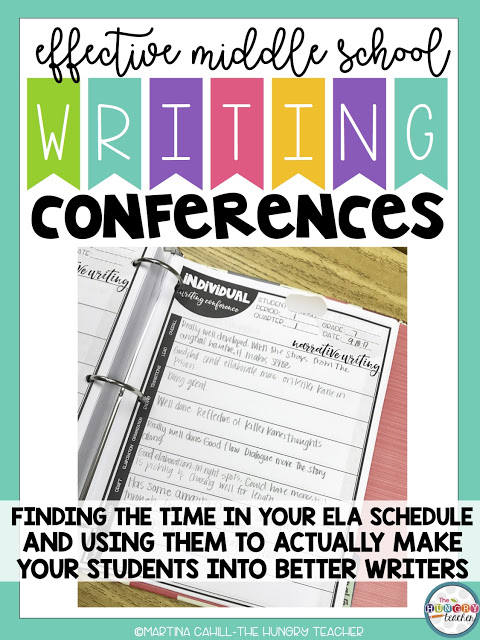
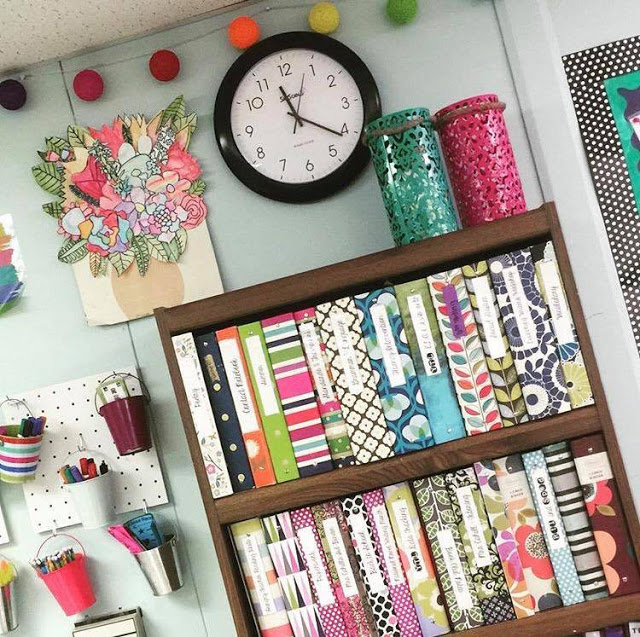







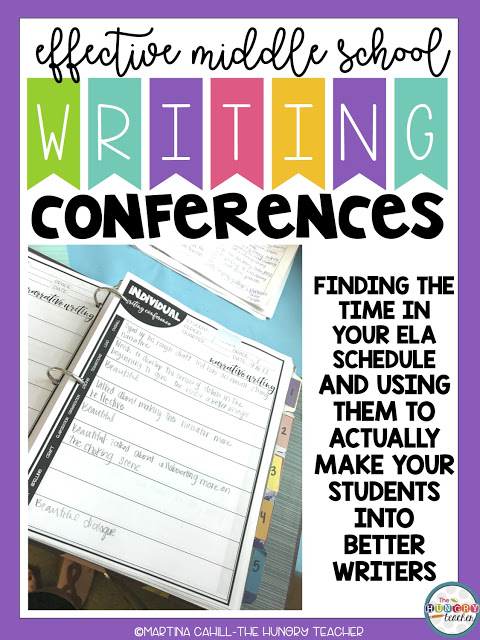
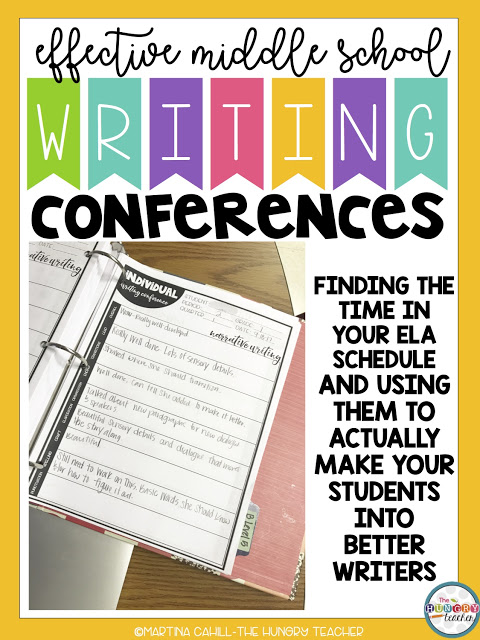
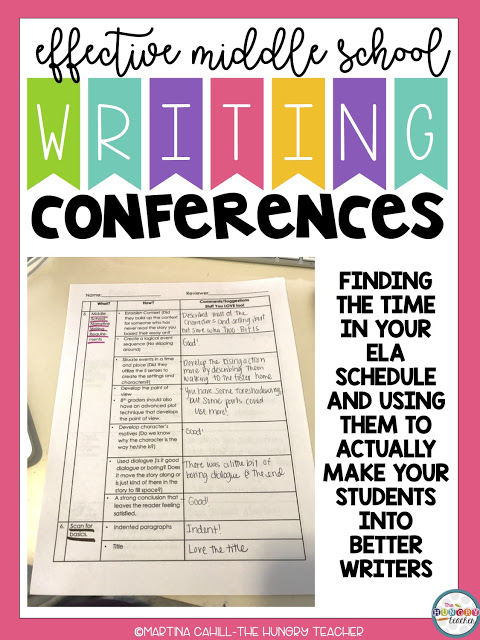
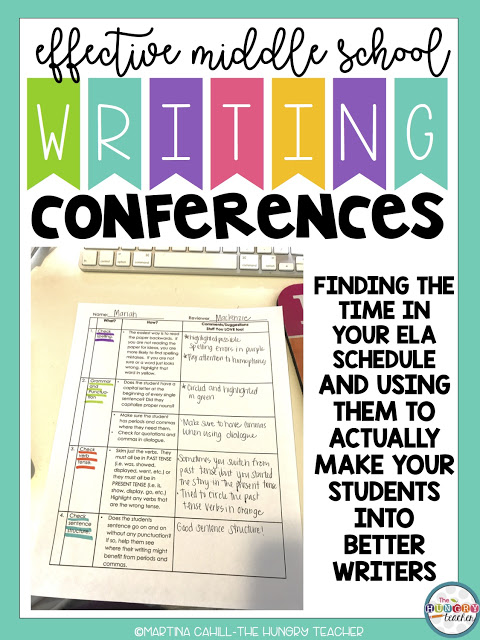
Thank you so much for sharing how you tackle conferring in middle school! This is one of my professional development goals every single year and I just can’t seem to get th to hang of it! I have a couple questions:
1. Do you read their writing and fill out the form right next to the student during the 30-40 minute writing time? Do they watch you fill it out? If not, what are is that one student doing while you are reading/writing about their work?
2. Do you have a conversation about each point that you noticed and jot down? Or let the student read it and ask questions? Or just point them towards the most important point?
3. Do you keep the form in your binder then afterwards? Do students ever ask to keep it?
Hi!
1. They just sit and wait and then we talk!
2. Depends on the student. The ones who want to talk about it will ask for specific feedback. The ones who don't want to talk about it, I just talk about one or two good things they're doing and one or two they can work on!
3. I keep it!
Thank you so much! 🙂
Nice, Thanks for posting
best carpet cleaners